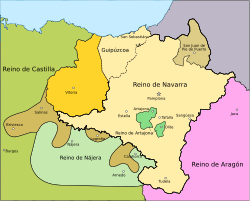This article needs additional citations for verification. (January 2024) |
Kingdom of Najera | |
|---|---|
| 923–1076 | |

| |
| Capital | Nájera |
| Religion | Catholicism (state religion) |
| Government | Feudal monarchy |
| King | |
• 923–970 | García Sánchez I (first) |
• 1054–1076 | Sancho IV (last) |
| Historical era | Middle Ages |
• Established | 923 |
• Disestablished | 1076 |
| Today part of | Spain |
The kingdom of Najera was a kingdom located in the north of the Iberian Peninsula between the years 923 and 1076, it covered the territories of the valley of the Ebro River, from the current Miranda de Ebro to Tudela. It was the precursor of the Kingdom of Navarra and cradle of the kingdoms of Castile and Aragón. From the year 925 onwards, the monarch of the kingdom of Nájera was the same as that of Pamplona and was renamed "kingdom of Nájera-Pamplona", which would be the predecessor of the kingdom of Navarra . The capital of the kingdom of Nájera was the city of Nájera, currently located in the autonomous community of La Rioja, Spain.
In the monastery of Santa María la Real is the royal pantheon where the tombs of the kings of the kingdom of Nájera-Pamplona, precursor of the kingdom of Navarra, are located. The kings of the Jimena dynasty, or the Abarca dynasty, are buried here, which remained on the throne from 918 to 1076, and the one that followed García Ramírez, who reigned from 1135 to 1234. This dynasty comes from the Abarcas dynasty.